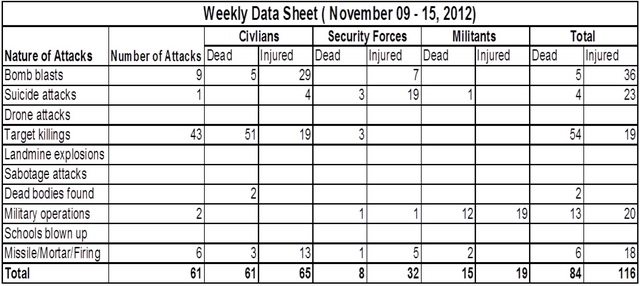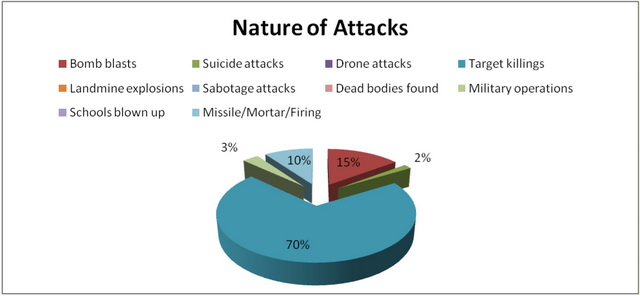The raging wave of violence receded significantly across Pakistan during the current week. Meanwhile, the unending spate of Ethno-political violence in the largest metropolis, Karachi, however surged substantially during the week, wherein almost 48 persons (compared to 36 last week) perished and another 41 got injured. Also, the wave of bomb blasts in Khyber Pakhtunkhwa (KP), armed clashes between militants and the security forces in Federally Administered Tribal Areas (FATA) and the recovery of mutilated dead bodies continued to mount death toll. The data collected throughten newspapers that CRSS uses as the source, indicates that as many as 84 persons lost their lives as a result of 61 violent incidents across the country during the reported week (for detailssee data sheet).The violent incidents also left 116 people injured.
As a common trend witnessed in the past several weeks, thecivilians bore the major brunt ofthe ongoing conflicts in the country this as civilians accounted for 72 percent of the total fatalities across Pakistan. Numerically speaking, 61 civilians lost their lives and 65 others were wounded in violent clashes of various kinds across the country. The second highest number of casualties were ofmilitants, wherein 15 militants were killed and another 19 got injured in violent clashes. Furthermore, for a third consecutive week, no CIA operated drone strikewas recorded in any part of the country. Also no significant sabotage attack was reported in any part of the country.
Death toll due to sectarian violence surged sharply during the week, as 18 sectarian attacksleft 28 men dead, 19 Shia and nine Sunni, and another 20 injured (five Shia and 15 Sunni) in different areas of Karachi (Sindh) and Quetta (Balochistan). Meanwhile, the loss of lives due to target killings surged sharply by 23 percent, (64 percent of the total dead against last week 41 percent) during the current week. Overall, 70 percent of the total violent attacks wereoftarget killingin nature.The trend also suggests that target killing insistently remains the preferred weapon in the hands of miscreants to inflict violence (seethe pie chart below).
Furthermore, data underlines that of the total 43 incidents of target killings; a staggering 86 percent took place in Karachi alone, decimating 44 people (81 percent of the total dead in target killings) and injuring 16 others. Death toll of the militants in the ongoing military operations in KP and FATA region dropped by one percent; militant casualties due to military operation accounted for 14 percent of the total fatalities against last week 15 percent. Meanwhile, eight security personnel were killed and thirty two others got injured during the week.
Also, two dead bodies were recovered from Karachi (Sindh) and Turbat (Balochistan) areas. In sum, the number of violent incidents surged from last week 58 to 61 during this week, the resultant death toll however, dropped sharply from 127 to 84 during the current week, while the number of wounded increased from 111 to 116.
Weekly violent trends underline that sectarian and ethno-political violence in Karachi and Quetta was responsible for major loss of lives during the week. In recent past, Karachi has emerged as the hub of sectarian violence, where the overall decline of law and order has created a deep security chasm, equally exploited by ethno-political and sectarian militants and criminals. The main political party in Karachi, Muthida Qaumi Movement (MQM), protested in the parliament against the prevailing apathy among the government circles to check and curb violence in the city, but to no avail as for now. Meanwhile, a suicide attack against security forces in Karachi underscores that given the fact of security vacuum in the city, Taliban are also sneaking into this densely populated urban center, with possible severe bearing on the already fragile security in the city.
Sources
- The News
- Dawn
- The Express Tribune
- Pakistan Today
- Daily Times
- The Frontier Post
- Jang (Urdu)
- Daily Mashriq (Urdu)
- Aaj (Urdu)
- The Nation


